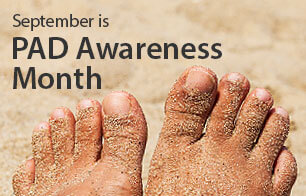 Peripheral arterial disease (PAD) is a common circulatory problem that affects the blood vessels outside of the heart and brain. It is usually caused by atherosclerosis, systemic plaque that results in a narrowing or clogging of the vascular system. PAD usually develops over a period of years or decades, ultimately eroding the effectiveness of the body’s circulatory system. If blood flow is compromised or cut off, the limb will not get enough oxygen, and the lack of oxygen can cause gangrene or tissue death.
Peripheral arterial disease (PAD) is a common circulatory problem that affects the blood vessels outside of the heart and brain. It is usually caused by atherosclerosis, systemic plaque that results in a narrowing or clogging of the vascular system. PAD usually develops over a period of years or decades, ultimately eroding the effectiveness of the body’s circulatory system. If blood flow is compromised or cut off, the limb will not get enough oxygen, and the lack of oxygen can cause gangrene or tissue death.
Symptoms of PAD
Symptoms of PAD include cramping, numbness, aching, or heaviness in the hips, thighs, or calves during exercise. Other symptoms include a weak or absent pulse in the legs or feet, lower extremity sores or wounds, pale or bluish skin color, a lower temperature in one leg than the other, poor toenail growth, and decreased hair growth on the legs.
PAD risk factors
The primary causes of PAD include smoking, diabetes, advanced age, high blood pressure, high cholesterol, coronary artery disease, lack of exercise, and genetics.
Know your ABI!
People who are at risk or who are experiencing symptoms should contact their physician, who can perform a simple, noninvasive ankle-brachial index (ABI) test. The ABI compares the systolic pressure in each ankle and in each arm to determine if blood vessels in the legs are narrowed or blocked.
Learn more about PAD at the National Institutes of Health website.